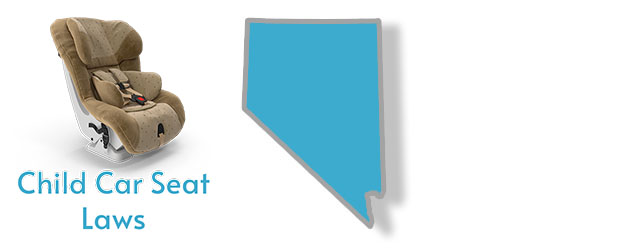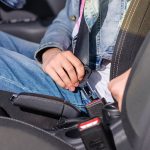
What Are the Height and Weight Requirements for Car Seats in Nevada?

Children should ride in rear-facing car seats from birth until age 1 or until the baby reaches the seats maximum weight and height limits.
The Nevada Department of Motor Vehicles recommends children should stay in a rear facing seat for as long as possible, but children aged 1-3 years can graduate to forward facing seats.
Nevada child-seat law requires children less than 6 years who are under 60 pounds to be secured in the appropriate child safety seat.
Children 4-7 years should ride on booster seats until they are big enough for safety belts.
Children younger than 12 years should ride in the back seat.
What are the Rear Facing Car Seat Laws in Nevada?

The state of Nevada does not have specific rules for rear-facing seats. However, the Nevada Department of Motor Vehicles says children should ride on rear-facing seats from birth until age 1 or until the baby reaches the maximum weight and height limits allowed by the manufacturer.
Most experts say that children should stay rear-facing for as long as possible. This is because the seat protects the most fragile parts of an infant such as the spine and head, which are still in early development.
You can use an infant-only seat until your child attains the age of 1 year, after which you can transfer him or her to a convertible seat, which allows you to keep the child rear-facing for a longer period (up to age 4) due to their higher weight limit (up to 40 pounds). Always secure your child in the back seat with the seat’s straps to limit movement in case of an accident.
What Are the Forward Facing Car Seat Laws in Nevada?

The Nevada Department of Motor Vehicles recommends children should stay in a rear facing seat for as long as possible, but children aged 1-3 years can graduate to forward-facing seats. Forward-facing seats usually have a 5-point harness and tether straps, which can be used to fasten a child to the seat. Make sure the straps are snug above the child’s shoulder. Two or more fingers should not fit in between the strap and collarbone. The seat should be firmly installed in the back seat and away from an active airbag.
Children can remain forward-facing for up to 7 years, due to some seats supporting weights of up to 65 pounds. Also, if your child’s ears are at the same level as the top of the seat, or if the shoulders are higher than the topmost harness slot, you can start using a booster seat as the child can be considered as big enough.
What are the Booster Seat Laws in Nevada?

Children who have outgrown rear-facing car seats should ride on booster seats until they exceed the weight and height limit set by the manufacturer. Nevada child-seat law requires children less than 6 years who are under 60 pounds to be secured in the appropriate child safety seat. This means your child can legally stop using a booster seat if they surpass either the weight or age requirement outlined in the child seat law. However, the Nevada Department of Motor Vehicles recommends children 4-7 years ride on booster seats until they are big enough for safety belts.
Belt-positioning booster seats help in raising a child so that they can fit in regular seat belts. The lap portion should snugly lie across the upper thighs, and the shoulder portion should lie flat across the middle of the chest. The booster seat should be installed in the back seat according to the manufacturer’s instructions. Do not use a lap-only seat belt with a booster seat.
Before transitioning your child to a safety belt, make sure he or she has reached a height of 4’9” since seat belts are designed to fit adults of this height or taller. Also, if your child can sit with his/her back straight against the back of the seat without slouching, and with knees bent at the edge of the seat, then he or she is big enough to use a seat belt.
When Can a Child Use the Front Seat in Nevada?

There are no clear rules regarding front seat use by children in Nevada. The Nevada Department of Motor Vehicles recommends children younger than 12 years should ride in the back seat. They further insist that rear-facing seats should never be put in front of an airbag. This is because airbags can deploy with huge forces, which can be dangerous to children. For those traveling with children in the front seat, the department says that the airbag should be turned off.
Is it Illegal to Leave a Child in a Car in Nevada?
It is illegal to leave a child younger than 7 years unsupervised inside a car. However, you are allowed to leave a child in a car if he or she is accompanied by someone 12 years or older.
Is it Illegal to Smoke in a Car With a Minor Present?
In Nevada no law prohibits you from smoking in a car with child passengers. However, it is recommended to refrain from doing so since secondhand smoke can be harmful to children.
Are Car Seats Required in Taxis in Nevada?

Children riding in public vehicles such as taxis and school buses are exempted from complying with the child restraint law. Also exempted are children being transported in an emergency vehicle. If a driver carries a note from a physician stating that a child restraint device is not suitable for the child because of issues such as weight, disability, or other medical conditions, then that child is not required to comply with the state’s car seat laws.
*Note – Although legal in Nevada, it is not recommended to travel in a taxi without a car seat
What is the Law on Replacing a Car Seat in Nevada?
The state does not have any clear laws regarding the replacement of car seats. However, most seats are usually replaced after 6 years. Check your seat or manual to see if it has an expiry date. Also, the National Highway Traffic Safety Administration recommends replacing your car seat after a moderate or severe accident.
More Nevada Laws